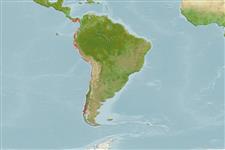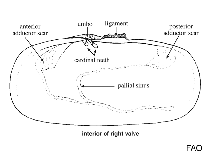Tagelus dombeii (Lamarck, 1818)
Hard razor clam| Native range | All suitable habitat | Point map | Year 2050 |

|
| This map was computer-generated and has not yet been reviewed. |
| Tagelus dombeii AquaMaps Data sources: GBIF OBIS |
Google image | No image available for this species;
drawing shows typical species in Solecurtidae.
Classification / Names Common names | Synonyms | CoL | ITIS | WoRMS
Bivalvia | Cardiida | Solecurtidae
Environment: milieu / climate zone / depth range / distribution range Ecology
Benthic; depth range 0 - 37 m (Ref. 87801). Subtropical; 9°N - 48°S, 83°W - 70°W
Distribution Countries | FAO areas | Ecosystems | Occurrences | Introductions
Eastern Pacific: Panama to Chile.
Length at first maturity / Size / Weight / Age
Maturity: Lm ? range ? - ? cm Max length : 7.8 cm SHL male/unsexed; (Ref. 105121)
Life cycle and mating behavior Maturity | Reproduction | Spawning | Eggs | Fecundity | Larvae
Main reference
References | Coordinator | Collaborators
Aguero, M. 2004 Chile. In Review of the state of world marine capture fisheries management: Pacific Ocean. De Young, C. (ed). 2007. FAO Fisheries Technical Paper 488(1). Rome, FAO. 170 p. (Ref. 82407)
IUCN Red List Status
(Ref. 130435: Version 2025-1)
CITES status (Ref. 108899)
CMS (Ref. 116361)
Threat to humans
Human uses
Fisheries: commercial
| FishSource |
Tools
More information
Max. ages / sizes
Length-weight rel.
Length-length rel.
Length-frequencies
Mass conversion
Abundance
Internet sources
BHL | BOLD Systems | CISTI | DiscoverLife | FAO(Publication : search) | Fishipedia | GenBank (genome, nucleotide) | GloBI | Gomexsi | Google Books | Google Scholar | Google | PubMed | Tree of Life | Wikipedia (Go, Search) | Zoological Record



